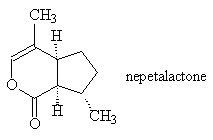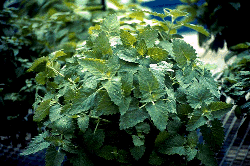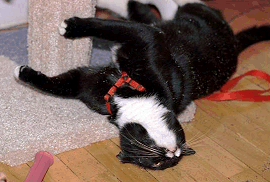



Nepetalactone is one of the major components (~ 40%) of the essential oils from Catnip, Nepeta cataria (photo above), a member of the mint family Labiatae. Other compounds found in the oils are common plant compounds like citral, geraniol, citronellol, nerol and limonene. When they inhale it, many (but not all) cats show a response lasting for a few minutes; symptoms include a head-over roll, body rubbing and kicking. Eating it has no effect, the vapour of the nepetalactone has to reach a receptor above the palate in the vomeronasal organ. The behaviour is believed to be an inherited characteristic related to an autosomal dominant gene. Nepetalactone has also been shown to be an active repellent for cockroaches, and recent tests on yellow fever mosquitoes showed that it was a more effective repellent than DEET (N,N diethyl-m-toluamide), the most popular synthetic insect repellent. It is not toxic; it was once even used to make a kind of tea used as a mild sedative and cure for insomnia. Nepetalactone has also been found as a pheromone component in some aphids such as Megoura viciae, Schizaphis gramium and Aphis fabae.

A cat going crazy on catnip